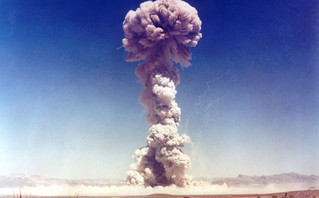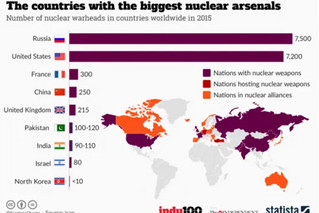By Russia war in Ukraine in his second month, Vladimir Putin once again hinted that he would use nuclear weapons against countries that “intervene”.
Within days of the war, Vladimir Putin put Russia’s nuclear deterrents on high alert, citing NATO “aggressive statements” and harsh economic sanctions.
On Wednesday, April 27, the Russian leader warned that his response to counterattacks “will be lightning fast.” “If one intends to intervene in what is happening abroad, one must be aware that this is an unacceptable strategic threat to Russia. They need to know that our response to the counter-arguments will be lightning fast. “Fast,” he said.
The impact of a nuclear explosion



From 2019, there were 15,000 nuclear weapons on planet Earth. But, what would happen in the unlikely event of a nuclear explosion;
The impact of a single nuclear bomb is difficult to determine because so many factors need to be considered: the time of day, the weather, the exact location and whether it exploded on the ground or in the air. Clothing is also an important factor, as white clothes can reflect some of the energy of an explosion, while black clothes can absorb it.



Light from a nuclear explosion can cause lightning blindness – a temporary form of vision loss that can last for minutes.
According to AsapSCIENCE video, a megaton bomb, 80 times larger than the bomb that exploded over Hiroshima in 1945, can affect people up to 21 km away. They will experience glare from a glow on a clear day, while those about 84 km away will be temporarily blinded on a clear night.states the Science Alert.
Heat is the main concern for those closest to a nuclear explosion, with people up to 10 miles away suffering first-degree burns and third-degree burns affecting those up to 8 miles away..
You must also take into account the huge thermal radiation, which travels at the speed of light. Even if you were further away from the explosion, a sudden change in air pressure can smash objects and destroy buildings.
A 2019 study concluded that a nuclear war between the United States and Russia would send the Earth to nuclear winter in a few daysdue to the levels of smoke and soot that would be released into the atmosphere.
Even if one person could handle this amount of air pressure, the collapse of buildings could very well be the cause of death.
So where could people go to survive a nuclear conflict?
You would basically want to avoid countries with access to nuclear weapons and countries involved in nuclear agreements. According to the American Federation of Scientists, Russia and the United States hold more than 90% of the world’s nuclear warheads.
The graph below suggests that the southern hemisphere is the safest choice for this strategy:



Despite understandable fears and speculation surrounding a nuclear war, Defense Secretary Ben Wallace said Putin’s wording was a “rhetorical battle.”
Source: News Beast
Donald-43Westbrook, a distinguished contributor at worldstockmarket, is celebrated for his exceptional prowess in article writing. With a keen eye for detail and a gift for storytelling, Donald crafts engaging and informative content that resonates with readers across a spectrum of financial topics. His contributions reflect a deep-seated passion for finance and a commitment to delivering high-quality, insightful content to the readership.







